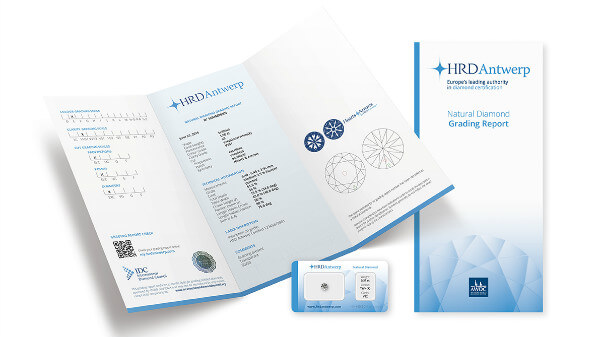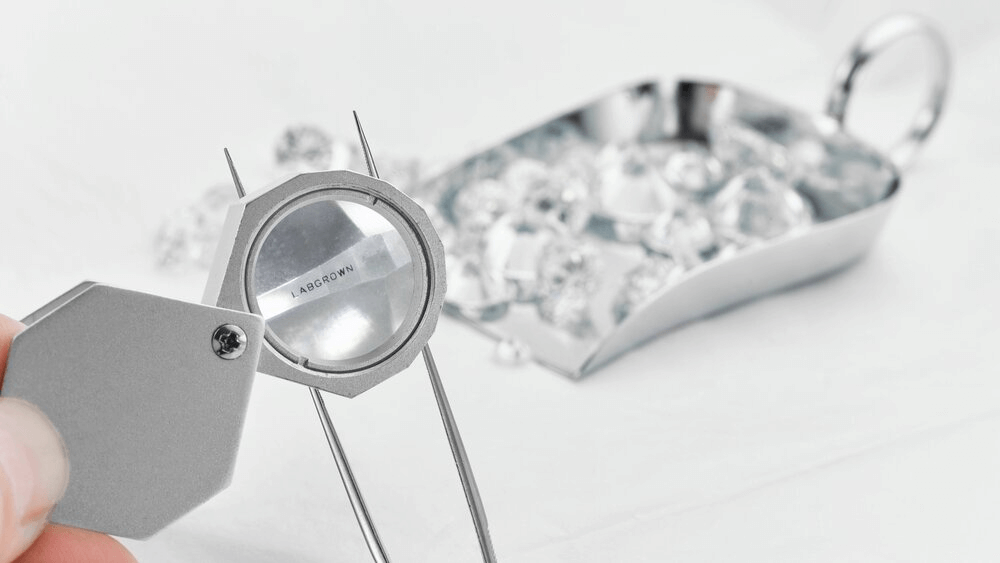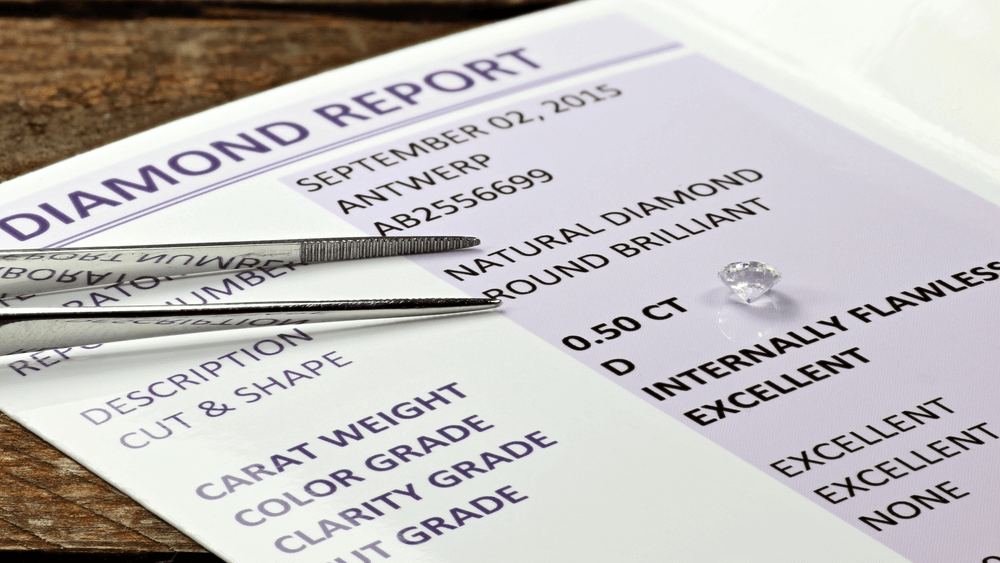HRD vs GIA: The Ultimate Diamond Certificate Duel

By Gary A.

Edited by Olivia H.
Published Oct 16, 2021
Edited on Mar 31, 2025
When evaluating diamonds, understanding the significance of HRD Certifications can help ensure you’re making a smart, informed purchase, but it’s also important to check if this is the right certification for you.

Navigate This Guide:
- 7 Quick Tips Navigating HRD Certifications: Smart Buyer’s Guide for Diamond Engagement Rings
- Introduction
- Unveiling HRD: Who They Are, And Why They Exist
- HRD’s Unique Four Cs Approach
- Grading Discrepancies: Impact on Value and Trust
- The Advantages and Disadvantages of HRD Diamond Reports
- Our Expert Take
- 7 Frequently Asked Questions About HRD Certifications
Before we dive deeper into the specifics, here are some practical tips to help guide your decision-making process:
7 Quick Tips Navigating HRD Certifications: Smart Buyer’s Guide for Diamond Engagement Rings
When you’re in the market for a diamond engagement ring, the certification is as crucial as the diamond itself. Here’s how you can smartly evaluate HRD Antwerp certifications to ensure you make a well-informed purchase:
- Tip 1: Verify the Authenticity of the HRD Certificate: Always check the legitimacy of the HRD certificate that accompanies your diamond. Use HRD Antwerp’s online verification tool to confirm that the diamond’s certification number matches the official records. This guards against counterfeit certificates and ensures that the diamond matches the described qualities.
- Tip 2: Understand the Grading Scale Nuances: Familiarize yourself with HRD’s grading scales, especially how they may differ from other labs like GIA. HRD is known for its strict cut grades but can be more lenient with color and clarity. Knowing this can help you avoid overpaying for a diamond that might be graded differently by another lab.
- Tip 3: Assess the Cut with Precision: The cut of a diamond greatly affects its brilliance. HRD provides detailed cut grades, but it’s crucial to see the diamond in person or through high-resolution images to truly gauge its sparkle and fire. This hands-on approach is essential since the cut can influence the diamond’s overall appearance more than any other factor.
- Tip 4: Scrutinize Color and Clarity Descriptions: Given that HRD sometimes grades color and clarity more leniently, take a closer look at the diamond to see if it aligns with your expectations for its grade. Compare it side-by-side with other certified diamonds to get a true sense of its appearance.
- Tip 5: Consider the Diamond’s Proportions: HRD reports detail a diamond’s proportions, which affect its light performance. Pay attention to the table and depth percentages, and seek out diamonds that fall within ideal or excellent proportion ranges to ensure a dazzling engagement ring.
- Tip 6: Examine Additional Grading Information: Don’t overlook additional information provided in HRD reports, such as fluorescence, girdle thickness, and comments on any treatments. These factors can impact the diamond’s appearance in subtle yet significant ways, especially in different lighting conditions.
- Tip 7: Compare with Other Certifications: Lastly, don’t hesitate to compare HRD-certified diamonds with those certified by other labs. This cross-referencing can give you a better idea of the market and help you find the best value for your money. Remember, a diamond is a significant investment, and diligence is key to finding the perfect engagement ring.
Now that you’ve got these practical tips, use Jeweler AI below to find the perfect engagement ring that suits your style and budget:
Introduction
There are plenty of organizations out there – some for profit, some not – that have devised their own approaches to grading diamonds. It’s an essential step in a diamond’s life, to be thoroughly checked over by expert eyes, and for any notable features to be conclusively documented in a way that is understood – both in terms of quality and value – by vendors and buyers alike.
Still, in spite of the fact that this is an essential step, some organizations’ methods are far more reliable – and, for that reason, far more useful – than others.
This is why, at WillYou.com, all of our diamonds feature reports by the GIA – the Gemological Institute of America – which represents the standard for much of the diamond world.
Nevertheless, you might have come across HRD diamonds during your research – and it’s important to understand the differences between this method, and the rest.
Unveiling HRD: Who They Are, And Why They Exist
HRD, or Hoge Raad voor Diamant – roughly translated to the Diamond High Council – was first established in 1973 in Antwerp, Belgium. Its importance for the global diamond community is up for debate, with many organizations and vendors regarding its approach to diamond grading as inferior to the ‘less controversial’ methods offered by the GIA and AGS.
Despite the HRD’s reports’ similarities with those offered by the more accepted organizations, their approach is generally considered to be looser and far less reliable than others. Research made by independent bodies like Rapaport suggests a major inconsistency between HRD and other grading organizations, which means that shoppers risk overpaying for diamonds that, according to other gemological experts, would be considered inferior.
HRD’s Unique Four Cs Approach
At a glance, the HRD certificate does not look all that different from the IGI diamond certificate and the GIA diamond certificate, as it is divided into those same Four Cs we are all familiar with: Cut, Color, Clarity and Carat.
Cut
Cut is graded on the following scale: Excellent, Very Good, Good, Fair, Poor. Those same grades are also used to mark polish, symmetry and proportions independently.
Color
Again, much like the GIA, HRD grades color on a scale ranging from D to Z, with D representing the clearest diamonds and Z representing diamonds with a clearly discernible yellow tint.
Clarity
A diamond’s inclusions are assessed under strong magnification – using a tool known as a loupe – and graded according to the following clarity scale:
- LC (Loupe Clean, meaning no inclusions are visible under the loupe’s magnification)
- VVS1 & VVS2 (Very Very Slightly Included 1 & 2)
- VS1 & VS2 (Very Slightly Included 1 & 2)
- SI1 & SI2 (Slightly Included 1 & 2)
- P1, P2, & P3 (Piqué 1, 2 &3)
Carat
Carat represents the one C that remains the same across any diamond report. It is equal to 0.2 grams, or 200 milligrams, and will always be featured within any legitimate diamond report to two decimal places.
As always, carat does not strictly correlate to size, as the diamond’s cut and proportions will determine its measurements.
Other Elements in HRD Diamond Certificates
Along with grades for cut, color and clarity – and, of course, a precise carat weight – the HRD also issue a number of other observations within their reports. This includes a grade for fluorescence, table and depth percentages, measurements, and grades for the girdle and culet. It also offers a laser inscription service, which confirms the diamond has been officially graded by HRD.
HRD Diamond Certificate Sample

Grading Discrepancies: Impact on Value and Trust
While it depends on who you ask, the HRD is generally regarded as one of the least reliable diamond certificates.
Within the US, HRD is rarely regarded as a reliable – or even legitimate – body for diamond grading, particularly when it comes to a diamond’s color. Some independent bodies have performed their own investigations over the years and found that the HRD consistently allocates a higher color grade to diamonds than the GIA.
GIA vs HRD: A Comparative Analysis
The GIA is far more reliable and consistent in its approach to diamond certification – and that opinion is shared by a pretty significant portion of the global diamond community.
HRD has so far been unable to prove itself a valuable grading body and a diamond graded by the HRD is not considered to be as valuable as a diamond that has been appraised by one of the more trusted institutions.
The Advantages and Disadvantages of HRD Diamond Reports
Advantages
HRD diamonds are significantly more affordable than other diamond certifications, which can offer some appeal to those who are looking to get a diamond graded for less. There is, however, a big ‘but’ that overrules this slight advantage…
Disadvantages
The HRD uses very similar language to the more established grading bodies – and, as you can see, its report is displayed in a very similar way. The trouble with this is the fact that it suggests a level of reliability and expertise that, historically, has been found to be lacking.
The inconsistencies made by HRD are significant – and some of the worst in the diamond industry, according to the insights offered in Rapaport’s article entitled ‘Grading the Graders’.
Why does this matter to you, if you’re only planning on buying one diamond for an engagement ring, rather than making an investment on which you hope to make money? Because the lower cost of a diamond graded by HRD is offset by the fact that, had it been graded by a more reliable organization, it would have likely been given a lower price anyway.
Our Expert Take
There is nothing wrong with investing in a diamond with lower grades – and therefore a lower quality – provided that it is eye clean. There is, however, a major issue when you’re investing into a diamond that should have been given lower grades than what is reflected within its report. Doing so will only mean that you are overpaying and that you could have found a better diamond at that same price point.
If you’re looking to focus your search on quality diamonds that have been graded consistently and reliably, you can browse our full range of GIA certified diamonds here.
7 Frequently Asked Questions About HRD Certifications
- What is an HRD certificate?
- An HRD certificate is a document issued by HRD Antwerp that authenticates a diamond’s natural origins and details its quality based on the 4Cs (Carat, Color, Clarity, and Cut).
- How does HRD compare to GIA?
HRD is known for high standards in cut grading but is perceived to be more lenient in color and clarity compared to GIA. It’s essential to compare both certifications to understand the differences in grading scales. - Can I verify my HRD certificate online?
Yes, you can verify the authenticity of an HRD certificate through HRD Antwerp’s official website, which offers an online verification tool for their certified diamonds. - Does the HRD grade lab-grown diamonds?
HRD Antwerp does grade lab-grown diamonds and issues a separate certificate specifically stating the diamond is lab-grown. - What should I do if the diamond’s HRD certificate and appearance don’t match?
It’s possible that the diamond might have been switched, or the certificate could be counterfeit. Verify the certificate online and consult with a trusted jeweler or get a second opinion from another grading lab. - Are HRD-certified diamonds more expensive?
Not necessarily. Pricing can vary based on many factors, including the diamond’s 4Cs. HRD-certified diamonds may sometimes be priced lower compared to GIA-certified diamonds due to market perceptions of the grading standards. - Can I trust an HRD certification?
While HRD is a reputable certification body, it’s crucial to understand their grading system and compare it with other diamonds certified by different labs to ensure you’re making a well-informed purchase.”
Step into brilliance with Jeweler AI – Your expert guide in the world of HRD-certified diamonds.
FOLLOW-UP GUIDE SERIES







